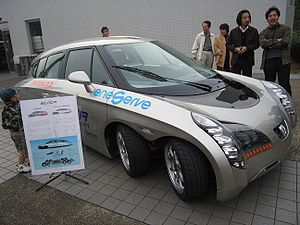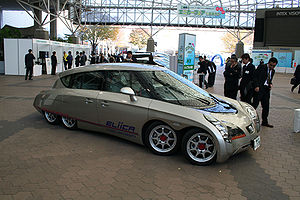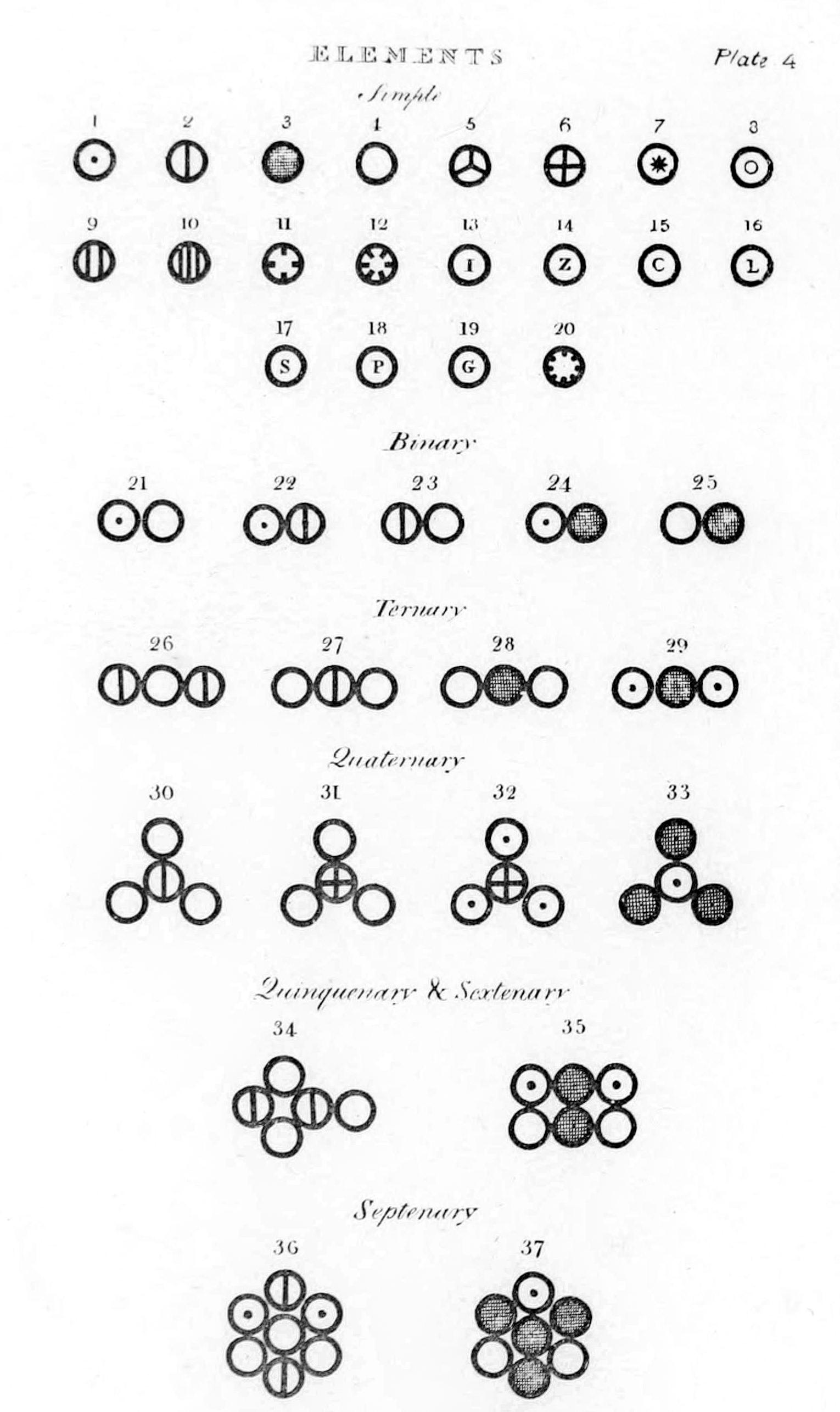Eliica... on Wiki

The Eliica (or the Electric Lithium-Ion Car) is a battery electric vehicle prototype, or concept car designed by a team at Keio University in Tokyo, led by Professor Hiroshi Shimizu. The 5.1 m (17 ft) car runs on a lithium-ion battery and can accelerate from 0–100 km/h (62 mph) in four seconds (faster than the Porsche 911 Turbo at the time).[1] In 2004, the Eliica reached a speed of 370 km/h (230 mph) on Italy's Nardò High Speed Track. The team's goal is to exceed 400 km/h (250 mph), breaking the record set by today's street-legal gasoline-powered vehicles.
Build your Own Electric CarHow can I build an Electric Car?
The one EV car I currently have (have 2 vehicles that run on hydrogen also) I converted from a vw bug and is free to charge. As I live completely off the grid all my electricity comes from solar panels and 2 wind generators, which I also built.
However I did charge up at Costco in Carlsbad California (I actually only drove up there to fill up) if I remember right it was around $2.00
Not sure if you’re interesting in doing it yourself, but I’d be willing to walk you step by step threw the conversion. I've converted 3 of my own cars (a datsun truck, ford ban, and a vw bug) and a few for neighbors. I've also converted cars to run on hydrogen, ethanol and biodiesel, by far EV is the easiest.
If you’re interested here’s what it would entitle…
- The engine compartment is first cleaned out of any gasoline components.
- Electric components are then installed in exchange.
- A battery bank is built and incorporated.
- Existing starter and driving systems are connected.
- Turn the key, step on the gas pedal sending more energy to the electric motor, & thus more power to the drive system, which in return creates more speed, more acceleration.
- The system has normal automotive top speeds and acceleration, typical to the vehicle your modifying. If your top speed was 85 mph and your acceleration was 1 mile per min, then this will be what your left with after the conversion.
The methods are extremely simple, making the process possible for anyone, everyone, ANYWHERE.
Typical tools, hardware & supplies are used, making access to parts available for all.
Electric Conversions can be easily accomplished in ANY model vehicle, even tractors, Generators, types of machinery, etc.
Project lengths range from 1 day to 1 month.
If you’re interested I wrote a guide on it which is available at www agua-luna com
My last EV conversion ran me about $1400. Everything is available online. I have a how to do it yourself guide available at www agua-luna com that will walk you step by step through the process. If you have ANY questions feel free to contact me through the site. Here’s a list of what you'd need...
Advanced DC Motor
The motor is an 8" Advanced DC series-wound motor. It weighs 107 pounds and is rated at 68 peak horsepower. These motors are available in several sizes.
Adaptor plate
The adaptor plate mates the motor to the transmission. It is constructed of 1/2 inch aluminum and is pre-drilled with bolt hole patterns for both the motor and transmission. An aluminum spacer is also used for proper spacing between the shafts of the transmission and motor. Adaptor plates are available for many cars.
DC Motor Controller
The controller regulates current going to the motor. It is a solid-state device that uses a pulse width modulator (PWM) that sends short bursts of current to the motor at a rate of 15 kHz. Controllers are available from both Curtis and DCP.
Potbox (Potentiometer)
The potbox is a 5K ohm throttle between the controller and the accelerator, similar to the way a sewing machine pedal works. The potbox's lever arm is attached to the existing accelerator cable.
Main Contactor
An electric relay that serves the same purpose as the ignition switch in a gas car. When the key is turned to the start position, the contactor closes the circuit to allow current to flow to the controller.
Circuit Breaker
A safety device that shuts down power for servicing or during an emergency. The circuit breaker is installed under the hood and can be switched both off and on from the drivers seat with an extension or cable.
Main Fuse
The main fuse protect the system from high voltage spikes. A fuse should be installed at each battery box or group of batteries.
Shunt
A shunt is placed in series within the wiring as a means to connect meters. Shunts are available in different sizes for both high and low power configurations.
Charger interlock
A relay that keeps the circuit open so nobody will inadvertantly drive off with the charge cord plugged into the car.
DC/DC Converter
The DC/DC converter is similar in function to a gas car's alternator. It charges the 12 volt accessory battery by chopping voltage from the main battery pack down to 13.5 volts.
If you interested I offer several DIY alternative guides to walk you step by step threw EV conversion process at agua-luna com or
www agua-luna com
Hope this helped, feel free to contact me personally if you have any questions if you’d like assistance in making your first self sufficient steps, I’m willing to walk you step by step threw the process. I’ve written several how-to DIY guides available at www agua-luna com on the subject. I also offer online and on-site workshops, seminars and internships to help others help the environment.
Dan Martin
Alterative Energy / Sustainable Consultant, Living 100% on Alternative & Author of How One Simple Yet Incredibly Powerful Resource Is Transforming The Lives of Regular People From All Over The World... Instantly Elevating Their Income & Lowering Their Debt, While Saving The Environment by Using FREE ENERGY... All With Just One Click of A Mouse...For more info Visit:
www AGUA-LUNA com

































